Chapter Two
Part Three
|

An advert from 1910. |
Though not so well remembered as John
Marston of Sunbeam or Edward Lisle of Star, James Burns
Dumbell was also a very astute business man who from small
beginnings built up a large and profitable business.
As we have seen Turner Motor
Manufacturing Company obtained a licence to build Miesse
steam cars which proved quite a success and in 1906 we find
Mr. Dumbell their managing director writing to the press
extolling the virtues of his cars with regard to the dust
problem. |
| In those early days dust really was a
nuisance and caused much antagonism against motorists.
Numerous chemical compounds were brought out for spreading
on the roads in an attempt to alleviate the problem, also
many patent devices were placed on the market. The RAC
organised trials of the various methods but none were really
satisfactory. Mr. Dumbell wrote that the Turner Miesse cars
caused little dust to be raised even at 25m.p.h. and over
due to the car being built fairly high and having no engine
flywheel revolving at high speed. Also no exhaust was sent
out onto the ground at great force as was the case with
petrol motors. At about this
time production of the steam car was going well. Turner's
found themselves with some surplus capacity and undertook to
build some petrol cars for Seymours, a London firm. The
Seymour Turner cars which were exhibited at the 1906 Olympia
Motor Show were about the largest cars that the firm would
build. The 4.1 litre cars had four cylinders with dimensions
of 100 x 130mm, high tension magneto, a four speed gearbox
with direct drive on top and shaft drive. It would seem that
these cars were only produced for about a year. |
| During the show a rumour got
around that Turners were about to abandon steam cars in
favour of the internal combustion engine. Mr. Dumbell
was at pains to deny this and again wrote to the press
strongly refuting the rumour and adding that his company
were soon to produce a steam vehicle to carry 20
passengers as well as a two ton goods chassis.
In the event not many of these were
made, though the steam car did continue for a number of
years. |
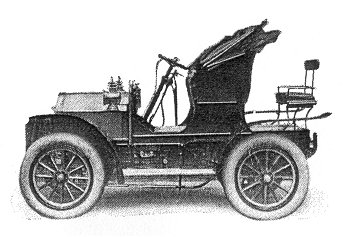
An early Turner steam car. |
| It can be seen that motoring was
getting popular in Wolverhampton by a report of the
Wolverhampton and District Automobile Club's opening
meet of 1907, a run to Newport for tea. The cars
assembled at West Park and of the 70 cars on parade, 32
were Sunbeams and 16 Stars. The Mayor, A.B. Bantock
arrived in a Sunbeam and despite very poor weather most
of the cars went off to Newport for tea. |
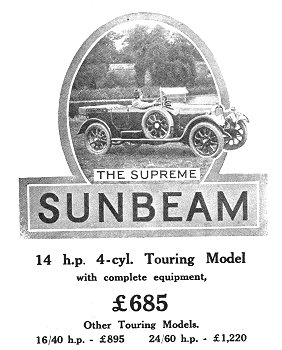 |
By this time Sunbeam had
gained an enviable reputation and were highly regarded motor
cars and of the excellent quality expected of a John Marston
product. Angus Shaw continued to design the cars and during 1909
brought out the 14/18 which had cylinder dimensions of 95 x
120mm giving an RAC rating of 22.4hp.
Features
included a leather lined cone clutch, a final drive by
side chains in oil bath chain cases, and was sold for
£425. The product range included 20h.p. and 35h.p.
models, the later costing £675. All were four cylinder
motors with cylinders cast separately. Also listed,
although not ready for production was a 14/20. This was
Louis Coatalen's first design for Sunbeam. |
| Louis Coatalen had now been appointed
Chief Engineer, a 30 year old Frenchman and brilliant
automobile engineer. He had worked for a number of French
motor firms before deciding to come to the UK. The French
industry had been going for a considerable time and
therefore had a lot of very competent engineers. The British
industry was still in its development stage and so would
offer much better prospects. Thomas Pullinger had taken much
the same view and as we have seen also worked at Sunbeam.
On arrival in England Coatalen had found work with Charles
Crowden, an engineer from Leamington Spa and a very early
expert in mechanical road traction, being in the business
before the turn of the century. Coatalen soon moved to
Humber's Coventry works where he designed a number of
successful cars. He then joined up with William Hillman to
produce the Hillman-Coatalen cars, on one of these he
finished 9th in the 1908 RAC Tourist Trophy.
It can be seen that
Louis Coatalen was keen on motoring competitions being a
firm believer that racing improves the breed. There would
not be another T.T. until 1914 when as we shall see a
Coatalen designed Sunbeam would be the winner.
Louis Coatalen left
Hillman and joined Sunbeam as Chief Engineer, and as noted
above his first design for them was the 14/20. The car
received much praise from the technical press, for this was
the first Sunbeam to have shaft drive. The engine had its
four cylinders cast in pairs with 'T' heads and dimensions
of 95 x l35mm. The car made its debut in the 1909 Scottish
Six Days Trial running throughout without an involuntary
stop of any kind. It was placed second in its class, whilst
a chain drive model received an RAC certificate for lapping
Brooklands at 57.67m.p.h. Production models began to reach
the public during 1910. |
| In his first Year at Wolverhampton
Coatalen also designed the 12/16, a four cylinder car with
dimensions of 80 x 120mm and many novel features including
forced feed lubrication without any external pipes on the
engine. It had overdrive on top gear, and the pistons were
drilled for lightness. Much attention was paid to clean
inlet and exhaust ports and this made a very efficient
engine capable of comparatively high r.p.m.
A car fitted with this engine was
timed over the flying start half-mile during 1910 at
71.98mph. and press reports of the car were most
complimentary. As noted above, Louis Coatalen was very keen
on motor sport. Brooklands the famous Weybridge track opened
in 1907 as the world's first purpose built motor racing
track. |
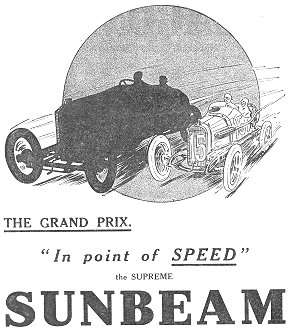 |
| Would-be expert Coatalen had taken an
interest in the goings on there and during the winter of
1909 prepared a car to compete at the track the following
year. The car had a specially tuned four cylinder engine
with dimensions of 92 x l60mm and sixteen overhead valves
and two camshafts, one each side. These were operated by
long pushrods and were driven by a chain. A very streamlined
body was fitted and the car named 'Nautilus'. It first
appeared at the Brooklands 1910 Easter Meeting and performed
well, but a collision between two other competitors forced
Coatalen to take avoiding action which put him out of the
race. This though was not the first Sunbeam competition
appearance at the track, for earlier in the day Louis
Coatalen had driven a stripped l6h.p. touring car to win the
Raglan Cup having covered the 8.5 miles at an average speed
of 55.5m.p.h. Sunbeam cars now gained many, very many
successes in competition, far more than it would be possible
to record here, but mention can be made that two of the
successful drivers at this time were N.F. Bayliss and L.V.
Cozens. For
1911 a new car was built for Brooklands, named 'Toodles II'.
It had a more conventional single seater body but was
considered mechanically daring, with chain driven single
overhead camshaft and valves inclined from opposite sides of
the cylinder head, operated by rocking levers. Very light
steel pistons were fitted and the four cylinder engine had
cylinder dimensions of 80 x 160mm. It proved very successful
taking 22 prizes during 1911 and winning a match race
against C. Bird's 60h.p. Napier. Remember the Sunbeam was
rated at only l5.9h.p., but it won by half a mile over five
miles at a speed of 83m.p.h. There were many more Sunbeam
successes in 1911, but the following year would see the
first really big international success for the Wolverhampton
firm with Louis Coatalen as designer. |
 |
First though we must move back and
consider what the Wolverhampton motorcycle firms had been
doing.
Sometime around 1908 D.H.& S.
Engineering of Sedg1ey Street, makers of the well known
Diamond cycles decided to build motorcycles and the company
became D.F.& M. from the initials of the founders, Dorsett,
Ford and Mee. |
| The first Diamond motorcycles had
imported FN engines, both single and twin cylinder versions
being available. The ‘V’ twin was mounted inclined forward
in the frame, the rear cylinder being near vertical to
assist cooling. Overheating was something of a bogey on ‘V’
twins, it would not seem that all that many machines were
made. During
1912 patents were taken out for a very advanced design of
motorcycle designed by Walter Ford, who was a very clever
engineer and his advice was sought by many other motorcycle
manufacturers. The 1912 design had a 2.75h.p. inlet over
exhaust engine, in unit with a two speed gear. A bevel wheel
drove two shafts, one of which drove the cone clutch, with a
final chain drive. |
| The other actuated the valves with
the chain fully enclosed. With most of the working parts
also under cover this Diamond was a very clean looking
machine. It was listed at
50guineas (£52.50) but few were made, and just when sales
should have been picking up the 1914 war put a stop to
production. A pity for here was a machine that did deserve
better sales. |
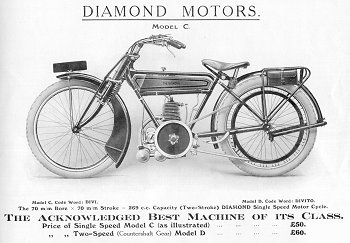 |
| Like most manufacturers Diamond
supported competition events, and did quite well in
reliability trials but were not really well known until the
1920s. Mr. Dorset, of D.F & M
was also connected with some other projects including a
rather unorthodox motorcycle introduced in 1909; the Omega.
Not to be confused with the better known machine of the same
name made by W.J. Green of Coventry in the 1920s. The
thinking behind the Wolverhampton machine was to attract
those who would shy away from ordinary motor bicycles and it
was very much on pedal cycle lines. Its 1.5h.p. air cooled
side valve engine being mounted low in the frame of a
heavyweight cycle in which the crankcase formed the bottom
bracket. The ingenious feature being that the cycle
pedalling gear passed through the crankshaft. The advantage
of which is that the pedals were always in the most
convenient position when needed, and the low engine position
gave a low centre of gravity making the machine stable and
not given to sideslip. The design also kept vibration to a
minimum. |
|
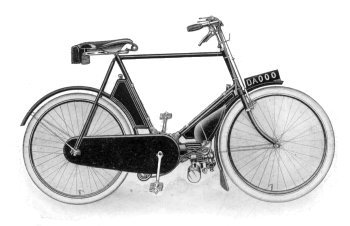
An Omega motor bicycle. |
Another advanced feature of the Omega
design was an epicyclic reduction gear and clutch contained
within the crankcase. Transmission was by separate chains
for power and pedalling which were enclosed in a gear case.
The specification included an AMAC carburettor, Simms high
tension magneto, Brooks saddle and Clincher or Palmer tyres
to choice. The machine was finished in black, lined in 2
colours and made in St. James' Square, Wolverhampton. It
weighed under 70lbs and cost 26 guineas(£27.30.). |
|
Ladies and gents models
were listed. For some reason this machine did not catch on and
is thought to have been produced for only one year, though it
was exhibited at the 1909 Stanley Show.
The Orbit also came from
Sedgley Street and Mr. Dorsett was in someway concerned with it.
Though it is said Orbits were available in 1913, like Diamond,
it would be after the war before they became at all well known.
|
 |
 |
 |
Return to
Part 2 |
Return to
the beginning |
Proceed to
Part 4 |
|